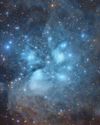Polaris, the North Star, is a single point in the night sky which the entire consortium of stars appears to revolve around. Despite being one of the most well-known stars in the sky, Polaris continues to confuse scientists. We still don’t know for sure how old the star is, or even exactly how far away it is from Earth.
The yellow supergiant is a Cepheid variable star, which means its brightness fluctuates by less than a tenth of a magnitude every few days. A common misconception is that Polaris is the brightest star in the sky, but this position is actually held by Sirius, with Polaris only ranking 48th in terms of luminosity.
Since Polaris isn’t incredibly bright or visible to us, how has it been our famous guiding star, escorting travellers for centuries? The answer is its location. Polaris is our one constant in the perpetually moving night sky, remaining in almost the exact same position above the northern horizon all year round. In Mongolian mythology, it’s considered to be the peg that holds the world together, and in Norse mythology, it was the end of a spike around which the sky rotates.
No matter where you find yourself in the Northern Hemisphere, if you locate Polaris, you know you’re facing north. If you want to take navigation one step further, you can measure the distance between Polaris and the horizon to discover a second valuable data point: your latitude. If you were to stand at the North Pole, Polaris would appear almost directly overhead – the star is slightly offset from the true north celestial pole by less than a degree.
Esta historia es de la edición Issue 120 de All About Space.
Comience su prueba gratuita de Magzter GOLD de 7 días para acceder a miles de historias premium seleccionadas y a más de 9,000 revistas y periódicos.
Ya eres suscriptor ? Conectar
Esta historia es de la edición Issue 120 de All About Space.
Comience su prueba gratuita de Magzter GOLD de 7 días para acceder a miles de historias premium seleccionadas y a más de 9,000 revistas y periódicos.
Ya eres suscriptor? Conectar

MYSTERIES OF THE UNI WHERE ARE ALL THE SPIRAL GALAXIES?
There are far fewer spiral galaxies than elliptical ones in the Supergalactic Plane, and scientists are keen to discover why

ZOMBIE STARS
+10 OTHER TERRIFYING SPACE OBJECTS

HOW TO BEAT LIGHT POLLUTION
Thought it was impossible to observe the wonders of the night sky from towns and cities? Think again. Follow our tips and tricks on successfully observing through sky glow

15 STUNNING STAR CLUSTERS
These beautiful stellar groupings are spattered across the cosmos

Eileen Collins "It was a difficult mission...we were the first to see Mir"
Having served as both the first female pilot and first female commander of NASA's Space Shuttle, Collins boosted the involvement of women in space exploration to a whole new level

MARS LEAKS FASTER WHEN IT'S CLOSER TO THE SUN
The Red Planet has lost enough water to space to form a global ocean hundreds of kilometres deep

FUTURE TECH KANKOH-MARU
This ambitious reusable spacecraft will be capable of taking 50 people to and from orbit

THE FINAL FRONTIER
Beyond the reach of the Sun is a fascinating region of the cosmos that were only just beginning to explore

A long-lost moon could explain Mars' weird shape and extreme terrain
A long-lost moon could explain why Mars is so different from the other rocky planets in the Solar System. Today Mars has two tiny moons.

A sprinkling of cosmic dust may have helped kick-start life on Earth
Cosmic dust may have helped kick-start life on Earth. New findings challenge a widely held assumption that this wasn't a plausible explanation.